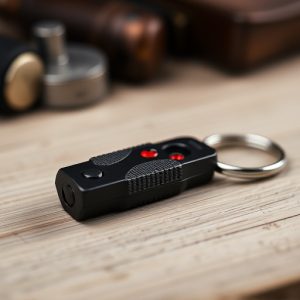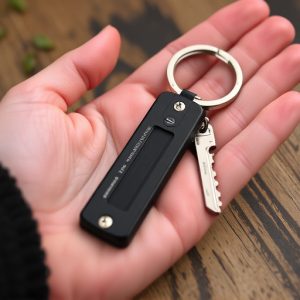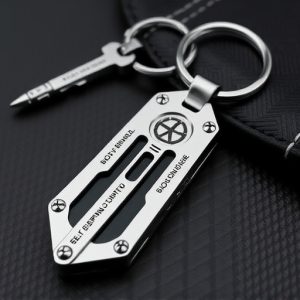Mastering Defensive Keychain: Legal Carry Guidelines State-by-State
Mastering keychain pressure point defense moves enhances self-defense capabilities, enabling users t…….
Mastering keychain pressure point defense moves enhances self-defense capabilities, enabling users to disable attackers without severe harm through strategic body point targeting. Regular practice is key for precise execution in real scenarios. Understanding state and local laws regarding concealed carry of tactical keychains is vital for legal protection while adhering to public safety regulations. Choosing durable, ergonomically designed keychains with sharp edges or points ensures effectiveness and compactness for easy carrying. Quick thinking during attacks can disrupt an assailant's balance using targeted moves on sensitive areas like eyes, throat, groin, or knees, creating opportunities for escape or de-escalation.
In today’s unpredictable world, understanding defensive keychain pressure point defense moves can be a lifesaver. This comprehensive guide delves into the legal considerations of carrying a defensive keychain, offers insights on choosing the right tool for maximum effectiveness, and provides effective techniques to implement during an attack. Additionally, we explore state-by-state guidelines, ensuring you navigate legal limits and permissions with confidence. Discover how these keychains can empower you while adhering to crucial legal carry standards.
- Understanding Keychain Pressure Point Defense Moves
- Legal Considerations for Carrying a Defensive Keychain
- Choosing the Right Keychain for Maximum Effectiveness
- Effective Techniques to Implement During an Attack
- State-by-State Guidelines: Navigating Legal Limits and Permissions
Understanding Keychain Pressure Point Defense Moves
Learning and understanding keychain pressure point defense moves is a crucial aspect of self-defense when carrying a keychain as a legal carry item. These moves focus on strategic pressure applied to specific points on an attacker’s body, allowing users to disable or temporarily incapacitate them without causing severe harm. By mastering these techniques, individuals can effectively deter and defend against potential threats, ensuring their safety in various situations.
Keychain pressure point defense strategies often target areas like the eyes, throat, groin, and knees. For instance, a swift press on the eyes can induce temporary blindness, while a firm grasp on the throat can disrupt breathing and balance. These moves require precision and timing, making regular practice essential for effective execution in real-life scenarios.
Legal Considerations for Carrying a Defensive Keychain
When considering legal aspects, it’s crucial to understand that carrying a defensive keychain for personal safety is subject to varying state and local regulations. In many jurisdictions, open display or ready access to self-defense tools like keychains equipped with pressure point defense moves are strictly governed. Individuals must adhere to specific laws regarding concealed carry permits and licensed weapons to legally defend themselves in public.
Each state has its own set of rules for what constitutes legal self-defense, including the use of keychains as a last resort. It’s essential to research and understand these guidelines, ensuring compliance with local laws to avoid any potential legal repercussions. Familiarizing yourself with the legal framework surrounding defensive keychain carry empowers you to protect yourself effectively while steering clear of any nasty surprises.
Choosing the Right Keychain for Maximum Effectiveness
When it comes to self-defense, every tool counts, and a well-chosen keychain can be more than just a convenience—it could be a powerful pressure point defense move in an emergency. Look for keychains designed with tactical functionality in mind, featuring sharp edges or points that can target sensitive areas like the eyes, throat, or groin. These keychains are often made from durable materials like stainless steel or titanium, ensuring they remain sharp and effective over time.
The best keychain for self-defense should also be easy to maneuver and comfortable to hold. Consider those with ergonomic designs that allow for a secure grip, enabling you to swiftly deploy the tool when needed. Additionally, keep in mind the size and weight—a compact yet robust keychain is ideal as it’s easier to carry around without feeling bulky or cumbersome. Mastering a few effective moves specific to your chosen keychain will enhance its utility, ensuring you’re prepared with a tactical advantage should unexpected situations arise.
Effective Techniques to Implement During an Attack
When facing an attack, quick thinking and effective techniques can be your best defense. One powerful strategy is to utilize pressure points on the attacker’s body, specifically targeting areas like the eyes, throat, groin, or knees. These keychain defense moves are designed to disrupt an assailant’s balance and breathing, providing a vital window of opportunity for escape or de-escalation. For instance, a swift jab to the eye or a well-timed knee to the groin can temporarily disable an attacker, allowing you to create distance.
Mastering these keychain pressure point defense moves requires practice and awareness. Regularly training in self-defense techniques, focusing on different scenarios and body positions, will help you react instinctively during an actual confrontation. Understanding when and how to apply these moves is crucial for effective self-protection, ensuring your safety and empowering you to handle potentially dangerous situations with confidence.
State-by-State Guidelines: Navigating Legal Limits and Permissions
Navigating state-by-state guidelines is crucial when considering defensive keychain legal carry for self-protection. Each US state has its own set of laws and regulations regarding concealed weapons, including keychains designed for pressure point defense moves. Understanding these laws is essential to ensure compliance and avoid potential legal issues. For instance, some states allow certain types of self-defense tools, like keychains equipped with tactical functions, while others have strict limitations on the type, size, and functionality of carryable defenses.
When exploring defensive keychain options, it’s imperative to research your state’s specific laws. Factors such as age restrictions, permit requirements, and allowed locations (e.g., private homes, public spaces) vary widely. By adhering to these guidelines, responsible individuals can legally protect themselves while respecting the legal framework designed to maintain public safety.
Understanding the legal framework surrounding defensive keychains is crucial for ensuring personal safety. By adhering to state-specific guidelines, individuals can effectively navigate potential legal issues while acquiring valuable self-defense skills. Armed with knowledge about pressure point defense moves and the right keychain tools, citizens can protect themselves in various situations. Remember, staying informed and choosing appropriate self-defense options are key to maintaining peace of mind.


